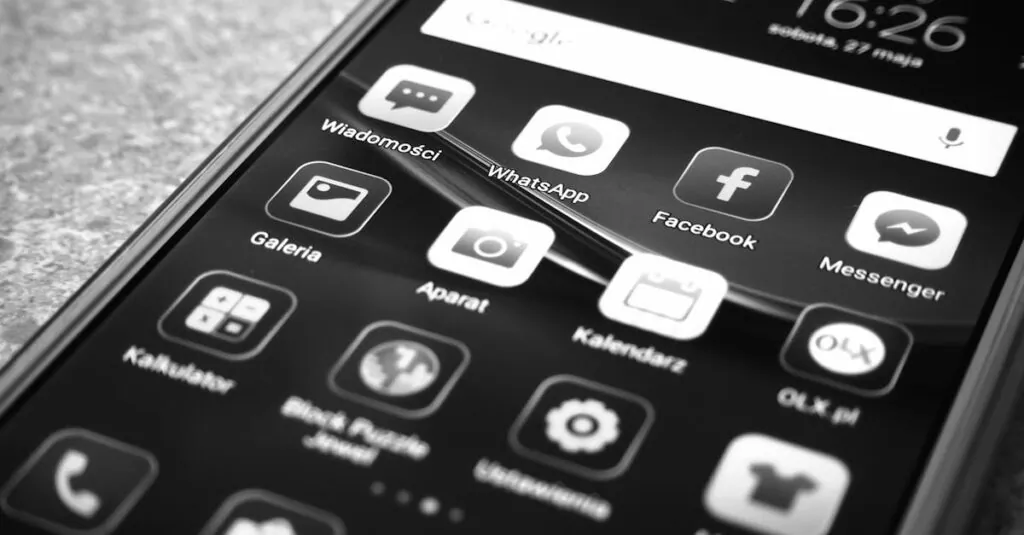In a world where texting has replaced handshakes and emojis speak louder than words, mobile chat apps have become the lifeline of modern communication. Whether it’s sharing a meme that perfectly captures Monday blues or coordinating weekend plans with friends, these apps are the unsung heroes of our daily lives. They’re like the Swiss Army knives of social interaction—compact, versatile, and always ready to help you navigate the chaotic world of conversations.
But not all chat apps are created equal. Some are designed for deep, meaningful connections while others are perfect for quick banter and sharing cat videos. With so many options out there, it’s easy to feel overwhelmed. Fear not! This guide will help you sift through the clutter and find the mobile chat app that suits your style, ensuring your chats are as lively as a Friday night out.
Table of Contents
ToggleOverview of Mobile Chat Apps
Mobile chat apps enable seamless communication across different platforms. They allow users to send text messages, share images, and initiate voice or video calls instantly. With various app options available, users can choose based on features that enhance their communication preferences.
Group chats facilitate interaction among multiple participants. Many apps offer this feature, making it easier to coordinate plans with friends or collaborate with colleagues. Custom emojis and stickers add a fun element to conversations, appealing to different user demographics.
Privacy and security also play crucial roles in the design of chat apps. End-to-end encryption ensures that messages remain confidential. Not all apps provide this level of security, so users should consider their privacy needs when selecting an app.
Notifications help keep users engaged. Customizable alerts allow individuals to prioritize important messages and minimize distractions. Multiple platforms support integration with other tools, enhancing functionality for productivity.
Some users prefer minimalist designs for straightforward communication. Others appreciate robust features that include file sharing and task management. Assessing individual needs allows users to find an app that aligns with their communication style.
Popular mobile chat apps, such as WhatsApp, Telegram, and Signal, offer different functionalities. Each app has unique features that cater to varying user preferences. When exploring options, examining user reviews and testing apps can aid in making an informed choice.
Popular Mobile Chat Apps
Many mobile chat apps cater to diverse communication needs. Each app offers distinct features and user bases, enhancing the user experience.
Features of Each App
WhatsApp boasts secure messaging with end-to-end encryption, voice and video calls, and diverse media sharing options. Telegram emphasizes speed and security, offering large group chats and channels for broadcasting information. Signal champions privacy with strong encryption practices and minimal data collection. Features like disappearing messages on Snapchat promote temporary interactions, while Discord focuses on gaming communities with voice channels and text chat. Each app provides unique functionalities designed to appeal to specific user preferences.
User Base and Demographics
WhatsApp has over 2 billion active users, spanning various age groups and regions. Telegram attracts tech-savvy individuals, often younger users, due to its flexibility in custom chat options. Signal appeals mainly to privacy-conscious individuals who prioritize secure communication. Snapchat attracts a predominantly younger audience, primarily teens and young adults drawn to its multimedia features. Discord has carved out a niche among gamers and communities, with a growing audience of users interested in group interactions. Each app serves distinct demographics, showcasing unique communication needs.
Comparative Analysis
Comparative analysis of mobile chat apps reveals critical factors that influence user choice. Key aspects such as security, privacy, usability, and user interface play significant roles.
Security and Privacy
Security stands out as a primary concern for users. WhatsApp employs end-to-end encryption, ensuring only the sender and recipient can read messages. Telegram offers optional secret chats, enhancing privacy through self-destructing messages. Signal is frequently lauded for its robust security features, which prioritize user anonymity. Developers frequently update these apps to address emerging threats and vulnerabilities, maintaining high standards of user safety. Users should always review the privacy policies of their preferred apps and opt for platforms that provide strong security measures.
Usability and User Interface
Usability significantly impacts user experience. WhatsApp features a straightforward design, enabling users to quickly navigate through chats and calls. In contrast, Telegram provides extensive customization options, appealing to those who enjoy tailoring their app experiences. Signal focuses on simplicity while delivering essential functionalities without overwhelming users. Users appreciate apps that load quickly and operate smoothly, as these attributes enhance overall satisfaction. Assessing personal preferences alongside app usability can guide users toward the most suitable mobile chat app for their needs.
Trends in Mobile Chat Apps
User preferences in mobile chat apps continue to evolve, shaping the way individuals communicate. Increased emphasis on privacy is notable, with many users prioritizing secure messaging options. Apps like Signal emphasize robust security measures, appealing to those who value confidentiality.
Customization options are gaining popularity, allowing users to personalize their experiences. Telegram provides extensive features like custom stickers and themes, fostering creativity in conversations. User interface preferences vary, with minimalistic designs favored by some, while others appreciate richer feature sets.
Real-time communication remains paramount, driving the popularity of features like video calls and voice messages. WhatsApp leads with its extensive user base, facilitating connections among friends, family, and professionals. Engaging group chats enhance community interactions, especially in platforms catering to niche interests.
Multimedia sharing is influential. Snapchat attracts younger users through its emphasis on images and videos, creating a dynamic chat experience. Users gravitate towards apps that enhance expression through fun elements like GIFs and emojis.
Cross-platform compatibility is crucial, allowing users to connect seamlessly regardless of device. Many apps now offer web features, ensuring accessibility from various platforms. A focus on integration with other services also enhances usability, allowing users to access multiple functionalities in one app.
Behavioral trends show a shift toward asynchronous communication, where users reply at their convenience. This trend supports a more relaxed interaction style, suitable for busy lifestyles. Notifications play a significant role, with customizable alerts helping users manage their chat priorities without feeling overwhelmed.
Overall, these trends illustrate the dynamic landscape of mobile chat apps, where user requirements continually shape features and functionalities.
Future of Mobile Chat Apps
The future of mobile chat apps showcases several emerging trends that could redefine communication. Privacy-focused features remain a top priority, as users demand stronger security measures. Apps like Signal already emphasize end-to-end encryption, setting a benchmark that others strive to meet.
Customization continues to enhance user experience, with options for unique themes, stickers, and emojis. Telegram exemplifies this trend with its extensive customization capabilities. Engaging users through personalized interactions fosters deeper connections and satisfaction.
Real-time communication becomes increasingly vital, as voice and video calls grow in popularity. Many users prefer instant messaging accompanied by multimedia options, driving apps to innovate. Snapchat leads the way in captivating younger audiences through dynamic image and video sharing.
Cross-platform compatibility is essential for a cohesive user experience. Seamless connectivity across devices enables users to communicate without barriers. This flexibility becomes more crucial as diverse devices and operating systems proliferate.
Another notable trend centers on asynchronous communication, allowing users to respond at their convenience. This approach encourages relaxed interactions, reducing pressure to respond immediately. As work-life balances shift, chat apps must adapt to these changing demands.
Overall, the landscape of mobile chat apps is evolving rapidly. Features that enhance security, customization, and user engagement will dominate future developments. As users’ needs and preferences continue to shape the market, developers must remain agile in delivering innovative solutions.
Mobile chat apps are transforming how people communicate in today’s fast-paced world. With a variety of options available, users can find an app that aligns with their preferences and needs. The focus on privacy and security is paramount, ensuring that conversations remain confidential.
As trends evolve, features that enhance user experience are becoming more prominent. Customization options allow for unique interactions, while real-time communication keeps users engaged. The future of mobile chat apps promises to prioritize user safety and personalization, making them essential tools for meaningful connections.










